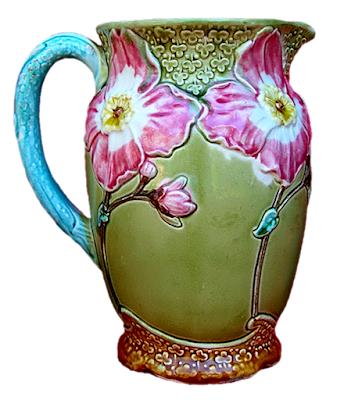The Chesapeake Pottery of Baltimore was founded in 1880 by brothers Henry and Isaac Brougham and partner John Tunstall. A small, single kiln operation of two buildings, the partners operated the business for two years before selling the company in 1882 to David Frances Haynes.
D. F. Haynes was born in Brookfield Massachusetts in 1835. An ambitious young man he was apprenticed in the sale of pottery. He was familiar with the Baltimore pottery trade and joined the firm of Ammidon & Co. in 1871, a wholesaler of pottery and related items. By 1877 he become proprietor and changed the name to D.F. Haynes & Co. Determined to bring locally produced quality ceramics to the American market. He purchased the Chesapeake Pottery from the Broughams and Tunstall and he hired two experienced potters from England to oversee the production of new lines of pottery at his new factory: Frederick Hackney and Lewis Taft. Taft had previously worked at Brownfield at Stoke-on-Trent and Hackney had experience at Wedgwood and at Fielding. Hackney was also a specialist in majolica. It is he who is credited with bringing majolica-type wares to the Chesapeake Pottery.
The pottery operations expanded quickly, offering nine different lines of ceramics across the next five years. In 1882 Haynes introduced Baltimore majolica. These included the majolica inspired lines of
Avalon Faience, and
Haynes Ware and a third,
Clifton Decor, which is in the only line offered by the company that is glazed in the tradition of true Victorian majolica.

Haynes catalog page for their Bramble pattern
Haynes catalog page for their Japonica series
The
Avalon Faience line was decorated in simple over-the-glaze monochromatic decoration trimmed in gold, similar to the decorated earthenware coming out of England and the
Venicene line produced at the Phoenix Pottery. (Note: The term "faience" was used in the late Nineteenth Century to denote any pottery of decorative nature.)
Haynes Bramble platter
Trade card promoting Hayes Avalon
Haynes Ware is usually covered in decal decoration with sections of color sprayed onto the pieces in a manner similar to some Continental ware. It was then finished with gold trim.
Clifton Decor followed the lead of Wedgwood and their
Argenta line of majolica. The basic ground of ivory was maintained and the ware was decorated with colored glazes before firing. It is the most conventional of the three Haynes lines and the one that most purists would say is the only "true" Victorian majolica made by the company. It included some solid colored wares as well.
Haynes majolica Japonica plate
Haynes majolica Bramble cake tray
Haynes majolica Oak Calvert ware clock
Haynes majolica Bramble vases
Haynes majolica Bramble series
Clifton Decor copy of a George Jones design
By 1887 financial strain forced Haynes to sell the pottery to Edwin Bennett, an English transplant and his main competitor in Baltimore, and the Chesapeake Pottery became a subsidiary of the Edwin Bennett Pottery Company.
In 1890, Haynes returned as general manager of the pottery, and entered into a limited partnership with Bennett. The Chesapeake Pottery operated under Haynes' supervision with the name of Haynes, Bennett and Company.
In 1895 Haynes bought out Bennett’s share and the company changed names once again to D.F. Haynes and Son. The company prospered for the next 14 years, winning ceramic awards at both the 1901 Buffalo Pan-American Exposition and at the 1904 St. Louis World’s Fair.
David Haynes’ genius was his sales and marketing acumen. His death in 1908 was the beginning of the end for the Chesapeake Pottery. Son Frank assumed proprietorship of the company after his father's passing but within two years sales began to decline. In 1914 the company entered liquidation proceedings and Haynes closed the pottery permanently. The pottery property was sold for demolition. Today the Domino Sugar factory occupies the site.
Haynes's pottery is not very popular today among traditional majolica collectors. Like the Wedgwood "Argenta" wares the white ground puts many people off. Collectors are usually attracted to majolica by the bright colors and Haynes majolica is the least colorful of them all. This shouldn't discourage you from buying it however if you find it attractive. As you can see by some of the photos, large groups can be quite stunning in their sophisticated beauty.
Haynes majolica has always been reasonably priced and remains so today.





































































